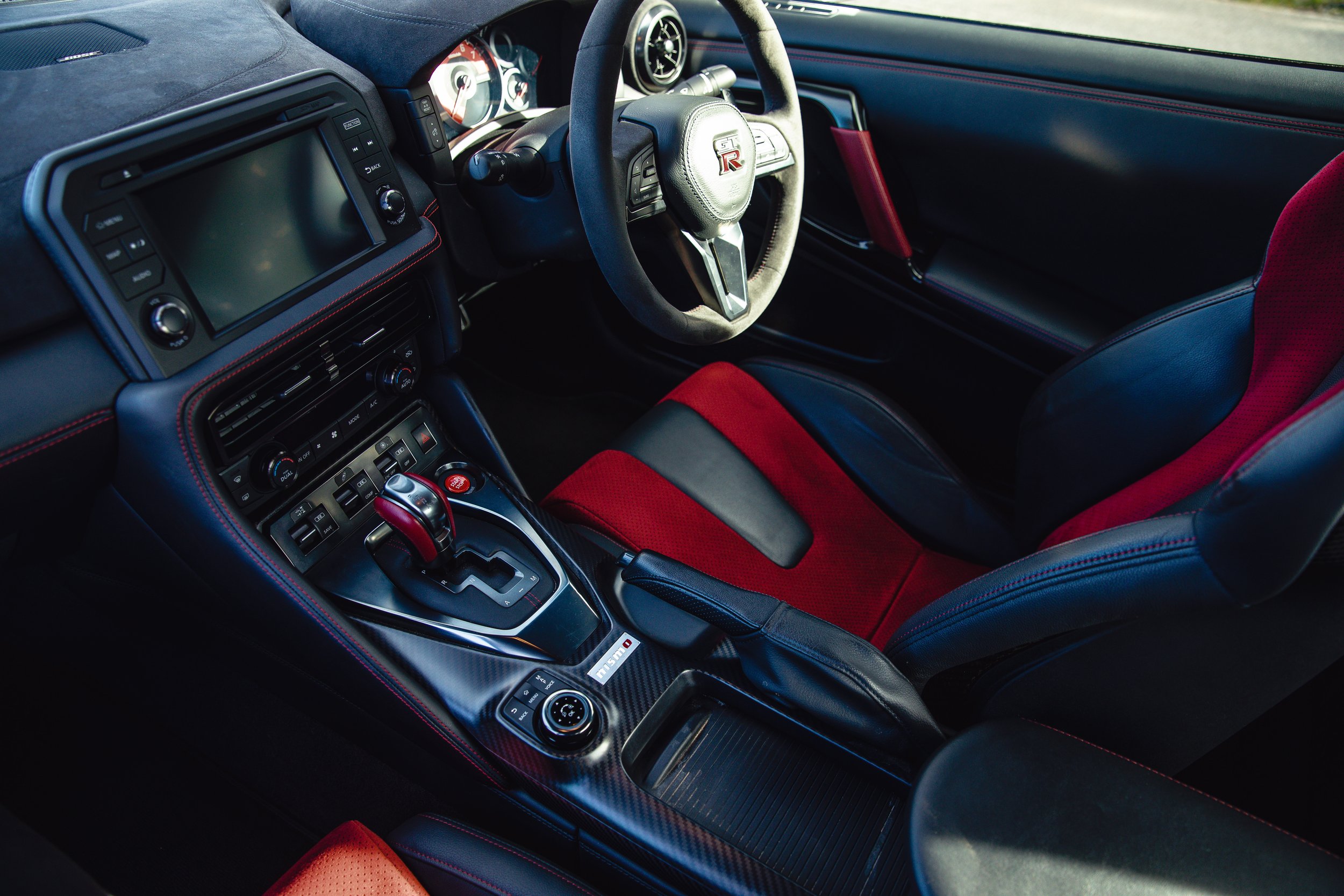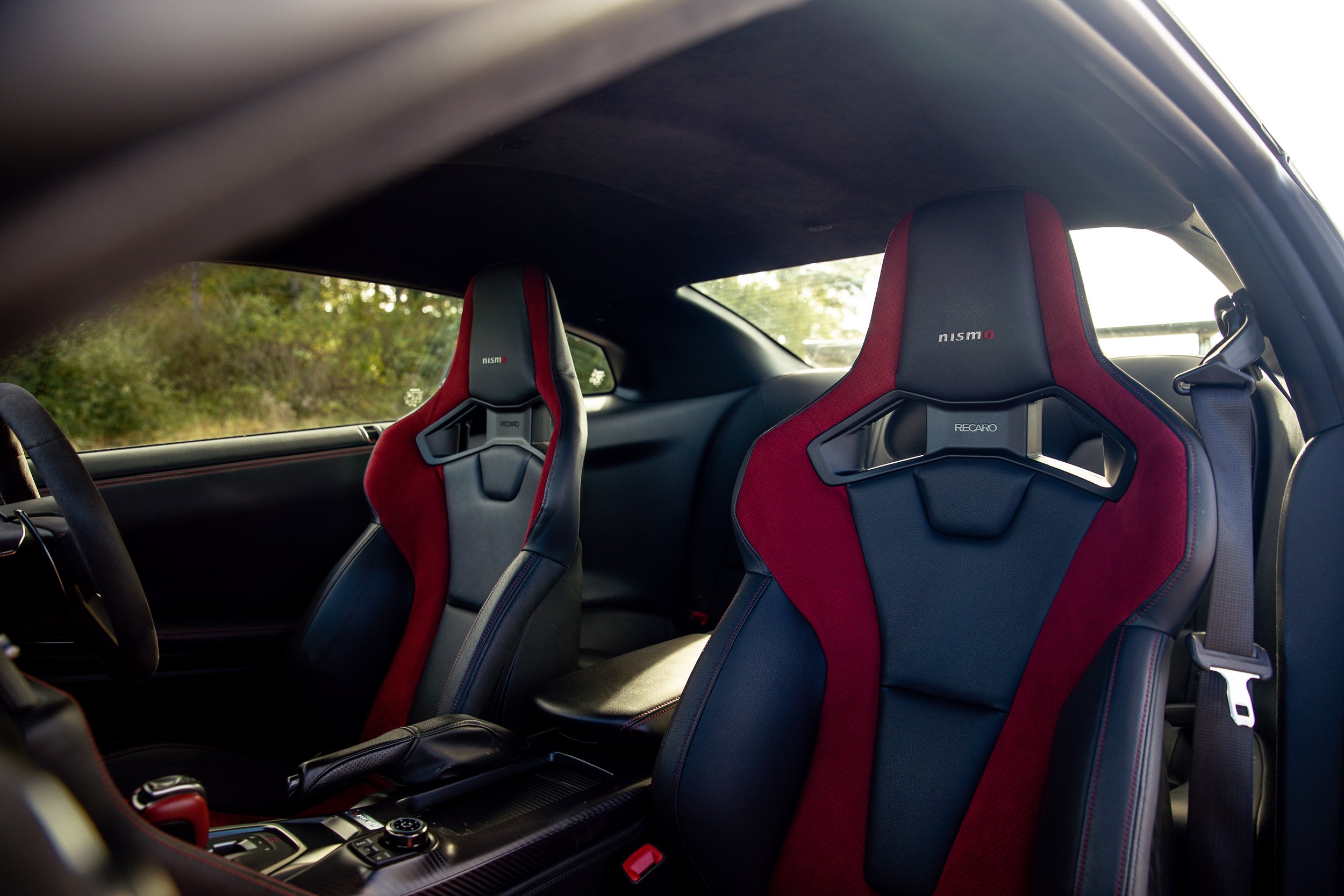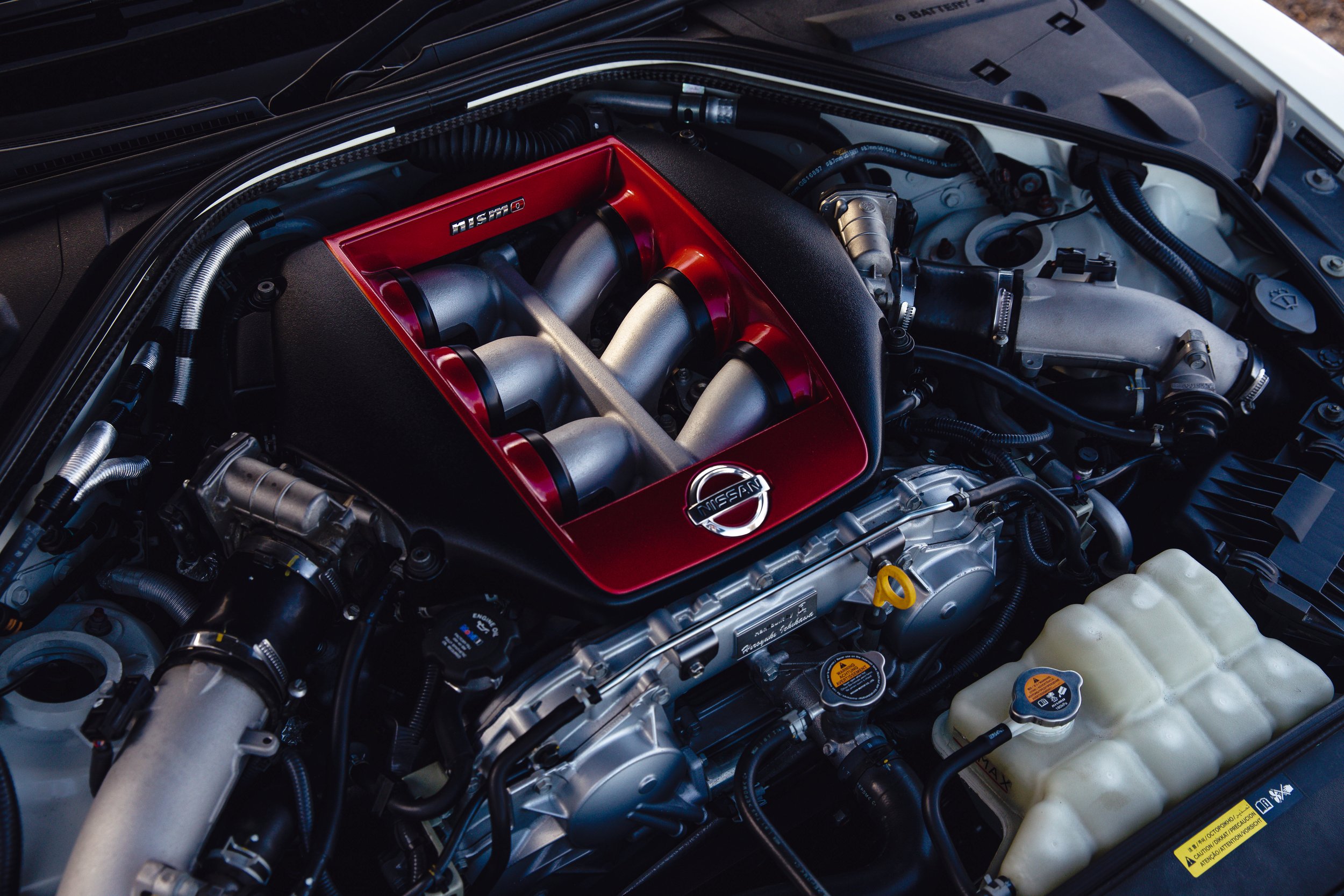
Road Test: Nissan GT-R Nismo
The Nissan GT-R Nismo is peak Godzilla, but can the king of the monsters still run with the best supercars on sale?
WORDS: Mark Rose | PHOTOS: Dom Ginn
Cast your mind back fourteen years to December 2007. Apple had just introduced the first iPhone, social media was in its infancy, and Bitcoin was still a twinkle in Satoshi Nakamoto’s eye(s). It was also when Nissan introduced the GT-R at a packed Tokyo motor show with a shiny, new Nürburgring lap time of 7m 38s – a time faster than that set by the 997 Porsche 911 Turbo. But Nissan’s statement of intent wasn’t the blistering, Stuttgart-spanking trip around the Nordschleife, it was the price tag that their new sports coupe boasted. When the GT-R went on sale, prices started from around £60,000 which seriously undercut its European rivals by many tens of thousands of pounds, plus you could get the kids in the back.
Since ’07, however, the world has changed dramatically. Most people now have a smartphone and a plethora of social media apps to hand, Bitcoin has gone from a very clever idea to a $2trillion asset class at the time of writing, and internal combustion is now firmly on the endangered species list, as is the GT-R. During the course of Godzilla’s life, there have been two all-new generations of Porsche 911 (991 and 992) plus their respective mid-life updates, three additional generations of mid-engine V8 Ferrari (458, 488, F8), and McLaren has come, seen and stolen a significant share of the supercar market with more models than I have space to write about. But the Nissan GT-R is still fundamentally the same car, albeit periodically improved with model year updates. If you thought Porsche’s approach to automotive engineering was evolutionary, then check out Nissan.
Godzilla then, is now a bit of an old dinosaur. Don’t be fooled though, Japan’s answer to the supercar establishment may be at the end of its life, but the latest Nismo version is still built to hold its own against the fast car elite. In transformation from the standard £83,000 GT-R to Nismo, Nissan has put it on a diet. The single largest weight saving comes from the carbon fibre body panels which strip 30.5kg from the kerbweight. This includes the front and rear bumpers, front fenders, bonnet, roof, side sill covers, boot and rear spoiler. The brakes which are now carbon ceramics measuring 410mm up front and 390mm at the rear, save a whopping 16.3kg in unsprung mass. These are housed within new 20-inch RAYS forged aluminium wheels which are a combined 100 grammes lighter. The turbos have been switched out for the ones that currently reside in the GT-R GT3 race car and are 14.5% lighter thanks one fewer vane than before. They also have the added benefit of spooling up 24% faster which helps reduce inertia. When you include some additional, smaller weight saving measures, the Nismo weighs 49kg less than a standard GT-R with a kerbweight of 1,703kg.


You’re probably reading this and thinking that 1,703 kilos doesn’t sound particularly light, but when you consider the GT-R has a large footprint, four seats, and carries around a chunky four-wheel drive system, you begin to realise how hard Nissan has worked to keep the heft down. When you drive it, any preconceived ideas of weight quickly vanish because it feels at least 200kg lighter than what the spec sheet says. Key to this is the reduced unsprung mass from the brakes and wheels, and the lower centre of gravity provided by the carbon roof, but hydraulic steering and specially developed Dunlop tyres also play their part. The tyres feature a new rubber compound which increases grip by 7% and the tread pattern has one fewer groove to help increase the contact patch by 11%. Cleverly, the tyre shoulder is slightly rounded so when the outside wheel is loaded up during cornering, more of the rubber stays in contact with the road. Nissan says this alone improves cornering grip by 5%, and out on the road when you really lean in to a turn, you can feel the extra contact patch biting in to the tarmac and pulling you round. Couple that with the most detailed steering feel this side of a McLaren, and what you have is a road car turned track weapon that makes an absolute mockery of B-roads.
On a country road, the GT-R Nismo feels like a laser-guided missile. You point the wheel, the nose goes exactly where you ask it, and then the natural grip hauls you round the corner with negligible roll from the chassis. But never does it feel like you’re playing a video game. It’s more connected than that. It feels raw, visceral, uncompromised, and alive in a way that modern performance cars rarely do. Your fingertips and backside feel as though they’re strapped to the tarmac beneath you, such is the Nismo’s ability to communicate what’s happening underneath. That said, it never feels like a track car pared back for the public road thanks to some welcome compliance from the suspension. There aren’t any driving modes per se, but you can make individual adjustments to the powertrain, suspension, and traction control. The best set up for road use is the powertrain in R mode, the suspension in comfort and the ESC left alone. The extra compliance offered by the comfort setting ensures the Nismo’s tyres stay in contact with the road instead of being deflected by bumps, which helps you build confidence behind the wheel. The ESC in its standard setting offers enough slip, particularly in damp conditions, but there is a more aggressive R mode and there’s the option to disable it entirely should you feel brave enough. Despite the four-wheel drive system and clever torque vectoring, the Nismo predominantly feels rear driven, but on occasion you can feel it throwing some torque forwards to help you round corners. It won’t play the hooligan, but on the other hand it doesn’t offer the safe, unrelenting traction of an Audi R8. It’s got more attitude than that.


On the subject of attitude, the Nismo has plenty of it at low speed. You never escape from the feeling that it was designed to go quickly and so it’s never truly happy until you are. When you fire it up it chunters in to life, it moves off with a stutter, and around town it’s generally a grumpy thing to drive. It lacks the low speed refinement that modern supercars have gained in recent years, but like a slightly miserable old man who ultimately means well, it has a charm and character to it. If that bothers you then may I offer a solution? Just drive it quickly, as frequently as you can.
It’s not like it’s lacking any straight line speed, either. In Nismo guise, the twin-turbocharged 3.8 litre V6 engine puts out 592bhp and 480lb ft via a six-speed dual-clutch transmission. Zero to 62mph is dealt with in sub-three seconds, and the top speed sits around 200mph. Interestingly, Nissan don’t quote any official performance figures for the Nismo which gives you an idea as to the level of focus that’s gone in to how it drives and not whether it can outrun the competition in a straight line. From behind the wheel though, it feels like a very fast machine, but the engine’s stand out attribute is its response. Those low inertia turbos that were thieved from the GT3 race car give the GT-R the kind of throttle response usually reserved for naturally aspirated cars, particularly when you have the powertrain ramped up in to its R setting. When the turbos come on song you can feel them fire you down the road, but the time you spend waiting for them to spool may as well be non-existent. The gearbox is also razer sharp. Sure, the transmission is clunky around town, but like the rest of the car, once you’re up to speed it scythes through ratios with immediacy. And those carbon ceramic brakes. Boy, are they good! Unbelievably, this is the first time Nissan has ever fitted carbon rotors to one of their road cars, and they’ve nailed it at the first attempt. Not only will they shred your face off if you need to stop abruptly, but the pedal feel is wonderfully progressive which allows you to judge your braking points to perfection. Driving the GT-R in anger is truly life affirming. There is a linearity between your thought process, subsequent inputs and the Nismo’s response to them. All you need to do is think about where you want to place the car and it will go willingly. As a driving tool, it is truly exemplary, but there’s also this sense that on the public road it is merely humouring you. In order to unlock its true potential, you must take it to a track.


Now, it was my intention to gloss over the interior because in truth, it’s not the point of the car and it is terribly antiquated. I will admit, it’s not £180,095 worth of cabin – yes that is the Nismo’s on the road price, deal with it – but supercars rarely command cockpits that sync with their price tag anyway. Nissan do give you plenty of Alcantara and carbon fibre for your money, but it still is traditional GT-R and therefore old. However, it’s also a breath of fresh air in a motor industry obsessed with buttonless cabin ergonomics and hi-tech infotainment screens. The instrument binnacle has manual readouts, there’s a manual handbrake, the touchscreen display has actual buttons, and low and behold, there’s a pair of twirly knobs for your heating controls. I recently spent a week in a new Cupra Leon 300 where all of the above (apart from the instrument cluster which was digital) were stuffed in to the infotainment system, and it was one of the most infuriating experiences I’ve had in a car. In contrast, operating the GT-R from behind the wheel was easy, and even though the on-screen graphics were pure PS2, the responsiveness of the system was pin sharp and easy to navigate around. It felt like good old common sense and ultimately allowed you to spend more time with your eyes on the road and your focus on the driving. Other car manufacturers could learn a lot from having a poke around a GT-R interior. My only real gripes were the seat which was set a little too high and the odd piece of loose interior trim. So, let me be clear about something, the fact the interior doesn’t meet the same standards as today’s performance vehicles is not a reason to avoid the car. If you truly appreciate driving, then you won’t be bothered by the cabin. On another subjective matter, what the GT-R lacks on the inside it more than makes up for on the outside. It is one bad-arse looking car.
While it’s clear the world has moved on considerably over the GT-R’s life span, the Nismo serves as proof that new doesn’t necessarily mean better. It’s also interesting how a car that once felt like it was at the forefront of technology now feels like a relic from the past, but in doing so offers us some well needed perspective on where the motor industry was, where it is now, and which direction it’s heading in. From a driving perspective, the Nissan GT-R Nismo is outstanding. It’s mechanical, involving, beguiling and oh so satisfying. Make no mistake, Godzilla is still very much at the top of its game, and when the King of the Monsters is finally killed off, the motor industry will be a slightly duller place for it.
Technical Specifications
Engine: V6, twin-turbo
Displacement: 3,799cc
Power: 592bhp @ 6,800rpm
Torque: 480lb ft @ 3,600rpm
Transmission: 6-speed twin-clutch, AWD
0-62mph: <3.0 secs
VMAX: N/A
Kerbweight: 1,703kg
Price: £180,095 (when new)
10/10
Rating
“All you need to do is think about where you want to place the car and it will go willingly”


